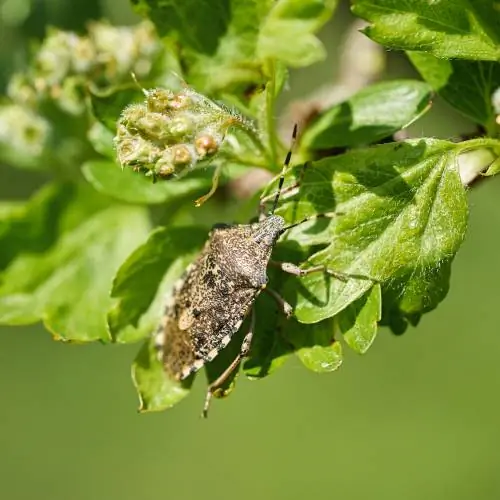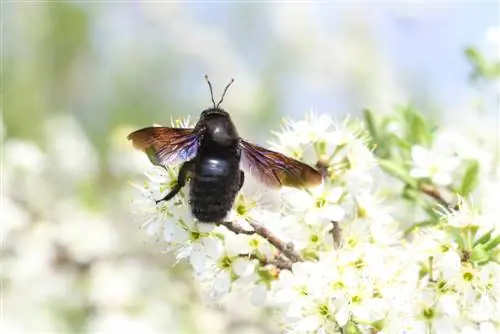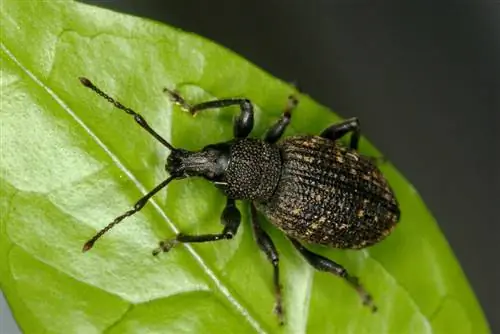- Author admin [email protected].
- Public 2023-12-16 16:46.
- Last modified 2025-01-23 11:21.
The garden bug is one of the species of bugs native to Central Europe that is becoming increasingly common in Germany. It has a very specific way of life and can occasionally be observed in houses. Specific conditions are responsible for this.
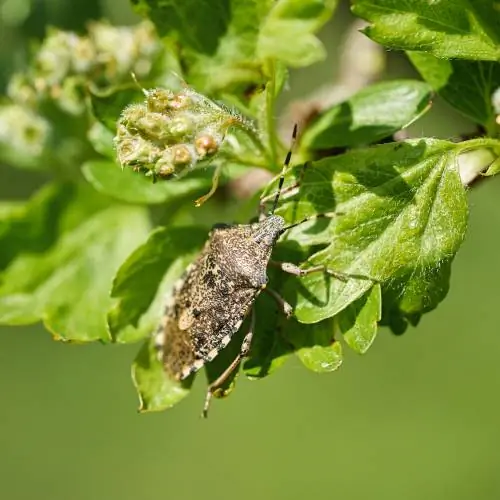
Are garden bugs dangerous or harmful?
Garden bugs are harmless to humans because they cannot sting or bite. They feed on plant juices and do not cause any relevant damage. Their defensive measure, a foul-smelling secretion, is not harmful to people or pets.
Are garden bugs dangerous?
If you discover garden bugs, you don't have to worry. The insects are not poisonous and cannot sting or bite with their stinging proboscis. They do not go to supplies and are not known to be pests. Only their defensive secretion can become a nuisance. The animals secrete this when they feel threatened. The substance is neither dangerous nor harmful to humans or pets.
Fighting gray garden bugs?
In most cases, fighting garden bugs does not make sense because the animals pose no danger. To combat pests, contact insecticides are used, which effectively kill the insects. However, these products are not harmless because they can harm he alth and have negative effects on the environment.
The garden bug is anything but dangerous. Fighting is only useful and recommended in extreme emergencies.
Pyrethroids
Products containing this synthetic insecticide are preferred for eliminating all types of bedbugs. The main active ingredients are based on the natural insecticide Pyrethrum, which is obtained from Tanacetum species.
This is how the remedy works:
- Effect: causes spastic paralysis in pests, which ends fatally
- Side effects: does not have a selective effect, but also kills beneficial insects
- Advantage: has a deterrent effect on bees in the wild
Diatomaceous earth
The chalk-like powder consists of fossilized remains of diatoms and is used to combat insects. Diatomaceous earth contains clay, iron oxide and silicon dioxide. When combined, the components ensure that the protective layer of the insect's shell is destroyed when touched. As a result, the bugs dehydrate and die.
Glue traps
The insects are attracted by sweet scents and stick to the tape. This method results in a lengthy and painful death and should be avoided.
What to do if there is a plague?
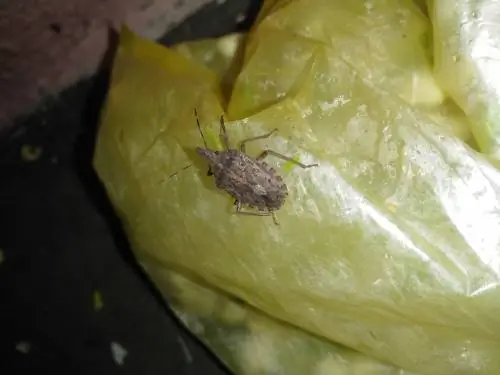
The garden bug is not welcome in the apartment
Instead of destroying the bugs, you should use repelling substances. There are some substances that bugs don't like at all. You can effectively drive away insects with home-made solutions.
Tip
Make sure there is a high level of humidity in the garden, because the garden bug loves dryness and heat. Mulch your plants regularly.
garlic
Spray a solution of 500 milliliters of water and four teaspoons of garlic powder into the bedbugs' locations. They are put off by the intense smell and look for another place to retreat.
Mint
Alternatively, you can mix half a liter of water with about ten drops of mint oil and spray this solution into the hiding places. Mint has a similar effect to garlic and does not poison the insects. Instead of mint oil, you can also use fresh peppermint or catnip leaves.
fly screen
To prevent bugs from getting into your apartment, you should put fly screens on your windows and doors. Make sure that all cracks and cracks are closed.
Tip
Birds and toads are natural enemies of bedbugs. Create a diverse habitat in which these animals feel comfortable.
Profile
Behind the garden bug is the gray garden bug (Rhaphigaster nebulosa), which is sometimes also called the common garden bug or gray field bug. The species belongs to the stink bug family. The insects are characterized by a clumsy body structure and a conspicuous pronotum.
Typical of stink bugs:
- shield-shaped body
- five-membered antennae
- well developed wings
Detecting bugs
The garden bug can be recognized by its gray base color, which has dirty yellow to brown nuances. Irregularly distributed pits can be seen on the body. The forewings are often covered by a dark brown mottled membrane. What is striking is the lateral edge of the abdomen, which has a black and yellow pattern. The antennae are also ringed in black and yellow, with the third and fifth segments always appearing yellow. Garden bugs have a stinging proboscis.
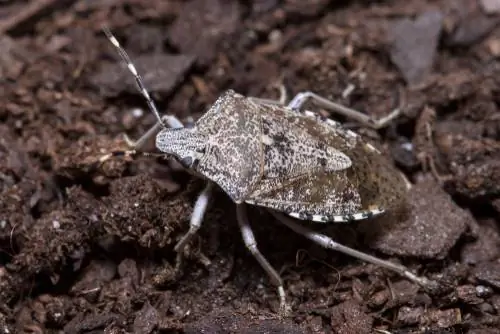
The gray garden bug has a beautiful gray-black pattern
Excursus
Blood-sucking bugs
Of the almost 900 species of bedbugs known in Germany, only five species can be considered bloodsuckers. They target the blood of birds and bats, but can also sting humans.
One of these species is Psallus varians, which reproduces in midsummer and exhibits rather unnatural behavior, especially in atypical weather conditions. In 2016, there were numerous reports of bites caused by this bug. The bite caused an allergic reaction in the form of mild inflammation.
Stunk Bugs
While many stink bugs are strikingly colorful, there are some species that are similar to the garden bug. Many species change their coloring depending on the season so that they are better protected from natural enemies. The bugs live in similar habitats as most species feed on plant juices.
| Coloring | Size | habitat | |
|---|---|---|---|
| Forest Guardian | brown with black dots | 10 to 13 millimeters | Forests, clearings |
| Stripe bug | red-black stripes | 8 to 12 millimeters | open to partially shaded areas |
| Common stink bug | green with dark dots | 12 to 13.5 millimeters | Deciduous trees, herb layer |
Name confusion
Sometimes all bugs that appear in the garden are referred to as garden bugs. Many of them, such as cabbage bugs, blackbirds or berry bugs, are feared plant pests and should not be confused with the gray garden bug. If you find bugs on your crops, you should first identify the species and then decide on possible control measures.
Lifestyle and development
The garden bug is active during the day and is tied to warm temperatures. It prefers to overwinter on facades that are overgrown with ivy. Cracks or crevices are often visited, so that the bugs often get into houses and apartments. Like all stink bugs, the garden bug only develops one generation per year.
From egg to bug
The females lay their eggs in late spring. You stick these in slices or strips to different parts of the plant. The hatched larvae are colored differently and do not yet have any wings. They go through several stages, between which they shed their skin. From the third instar, short stubby wings are visible.
Behaviour
Larvae and adult bugs exhibit similar behavior. To ward off enemies, the animals secrete a smelly secretion. The insects are not good at flying. Loud buzzing sounds can be heard during their lumbering flight.
Food
Garden bugs live on various deciduous trees and feed on plant juices. Leaves and fruit are also on their menu. To get to the liquid, they use their long proboscis. They occasionally use this to suck out dead insects.
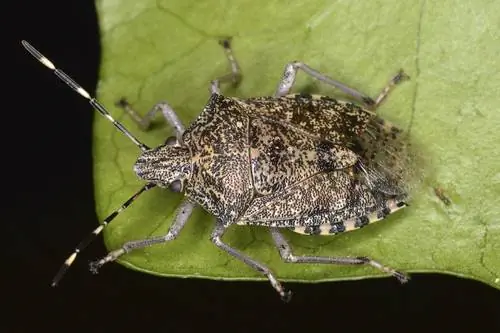
The gray garden bug is a herbivore
Wintering
In winter, garden bugs form aggregations in their overwintering quarters to keep each other warm. They use various crevices and cavities that provide sheltered conditions. These can be cracks in walls or bark flakes on plane trees. Garden houses or nesting boxes also serve as winter quarters.
Dissemination
The gray garden bug is the only species of the genus Rhaphigaster found in Central Europe, although it is more common in the south than in the north. The species has spread significantly in Germany since 2000 and is now also found on the northern German coast. The garden bug is more common in cities than in the surrounding areas. This is due to the increased warming of urban areas, which promotes the spread of the species.
In the apartment
When winter is approaching, garden bugs start looking for winter quarters. Attracted by light sources and warmth, the insects get lost in apartments and houses. They get into the rooms through open windows and doors where they do no damage. A plate of fruit on the living room table magically attracts the bugs. They suck the juice out of peaches, pears or apples and leave behind spoiled fruit.
On the house wall
In some years, garden bugs can be observed in large numbers on house walls. Such mass gatherings are particularly common in warm years because the animals can reproduce well under these optimal conditions. The heat-loving insects settle on the sunny side of house facades and can accidentally enter the apartments. As soon as the sun disappears and the temperatures drop again, the bugs are gone too.
Frequently asked questions
Do garden bugs stink?
Many stink bugs have stink glands that allow them to emit a foul odor. Some of the substances are toxic and can stun attackers or prey. Garden bugs also have these stink glands, which are located on the underside of their chest. Even the nymphs use the glands to ward off enemies.
Do bedbugs indicate an unhygienic apartment?
If you find garden bugs in your home, there is no need to worry. Stink bugs have no interest in human food or moist niches. They are simply looking for suitable winter quarters and retreat into warm niches.
Can garden bugs bite?
Even if the insects appear worrying with their long stinging proboscis, the animals cannot sting through human skin. They use their mouthparts to pierce the outer skin of leaves or fruits. Occasionally they also suck out dead insects.
When are garden bugs active?
The insects come out of their winter quarters as soon as the thermometer rises above ten degrees Celsius. They usually go looking for food at the beginning of March. If the winter is particularly mild or ends early, the insects can be observed earlier.

